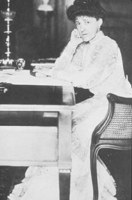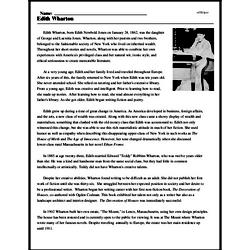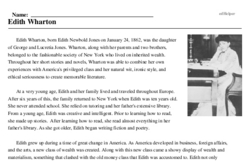Edith Wharton
Edith Wharton, born Edith Newbold Jones on January 24, 1862, was the daughter of George and Lucretia Jones. Wharton, along with her parents and two brothers, belonged to the fashionable society of New York who lived on inherited wealth. Throughout her short stories and novels, Wharton was able to combine her own experiences with America's privileged class and her natural wit, ironic style, and ethical seriousness to create memorable literature.
At a very young age, Edith and her family lived and traveled throughout Europe. After six years of this, the family returned to New York when Edith was ten years old. She never attended school. She relied on tutoring and her father's extensive library. From a young age, Edith was creative and intelligent. Prior to learning how to read, she made up stories. After learning how to read, she read almost everything in her father's library. As she got older, Edith began writing fiction and poetry.
Edith grew up during a time of great change in America. As America developed in business, foreign affairs, and the arts, a new class of wealth was created. Along with this new class came a showy display of wealth and materialism, something that clashed with the old money class that Edith was accustomed to. Edith not only witnessed this change, but she was able to use this rich materialistic attitude in much of her fiction. She used humor as well as empathy when describing this disappearing upper-class of New York in such works as The House of Mirth and The Age of Innocence. However, her tone changed dramatically when she discussed lower-class rural Massachusetts in her novel Ethan Frome.
In 1885 at age twenty-three, Edith married Edward "Teddy" Robbins Wharton, who was twelve years older than she. He was a kind and handsome man from the same social class, but they had little in common intellectually or artistically. Teddy did not have Wharton's creative talents.
Despite her creative abilities, Wharton found writing to be difficult as an adult. She did not publish her first work of fiction until she was thirty-six. She struggled between her expected position in society and her desire to be a professional writer. Wharton began her writing career with her first non-fiction book, The Decoration of Houses, co-authored with Ogden Codman. This book exhibited her talent not only as a writer but also as a landscape architect and interior designer. The Decoration of Houses was immediately successful.




